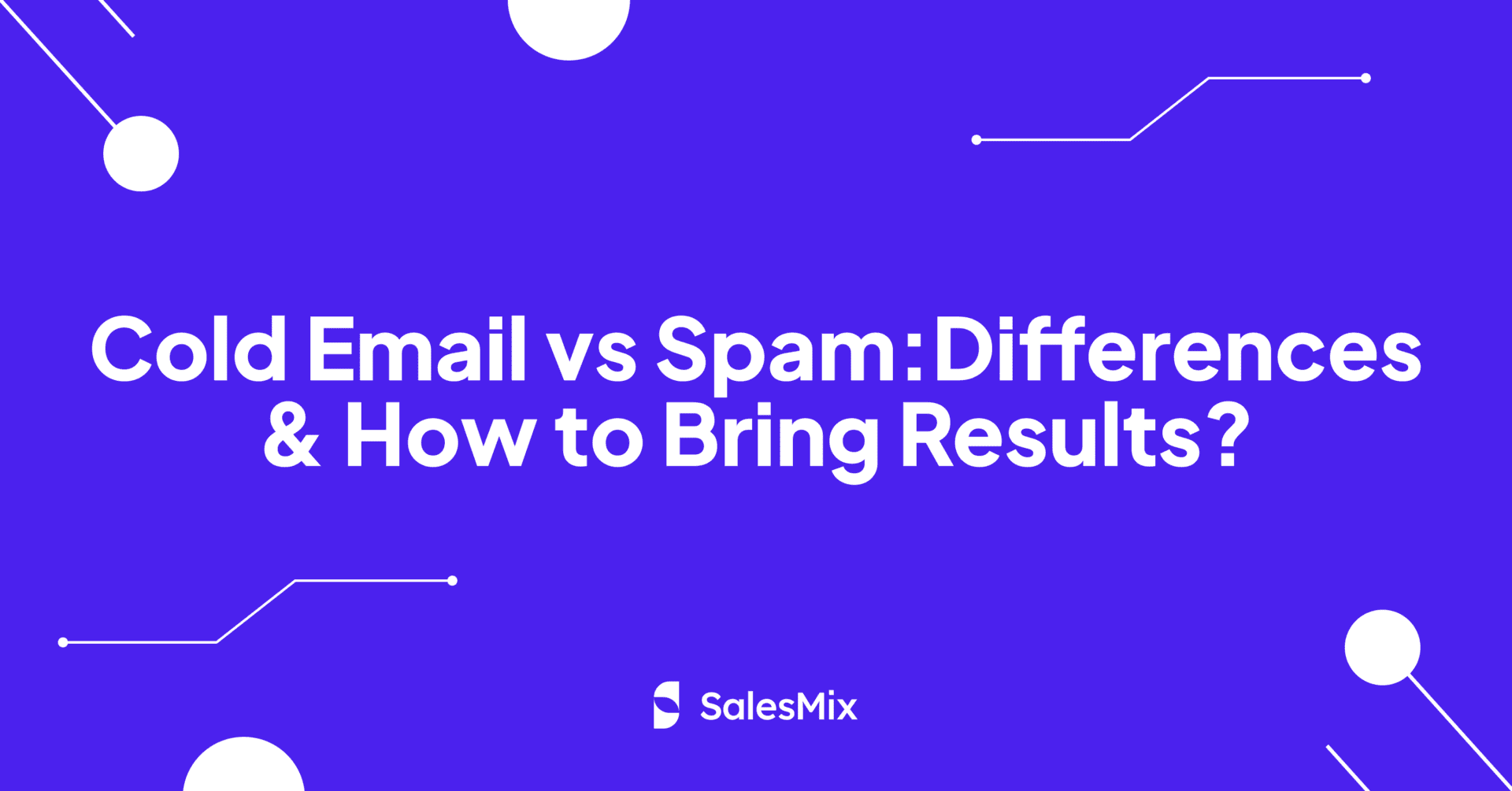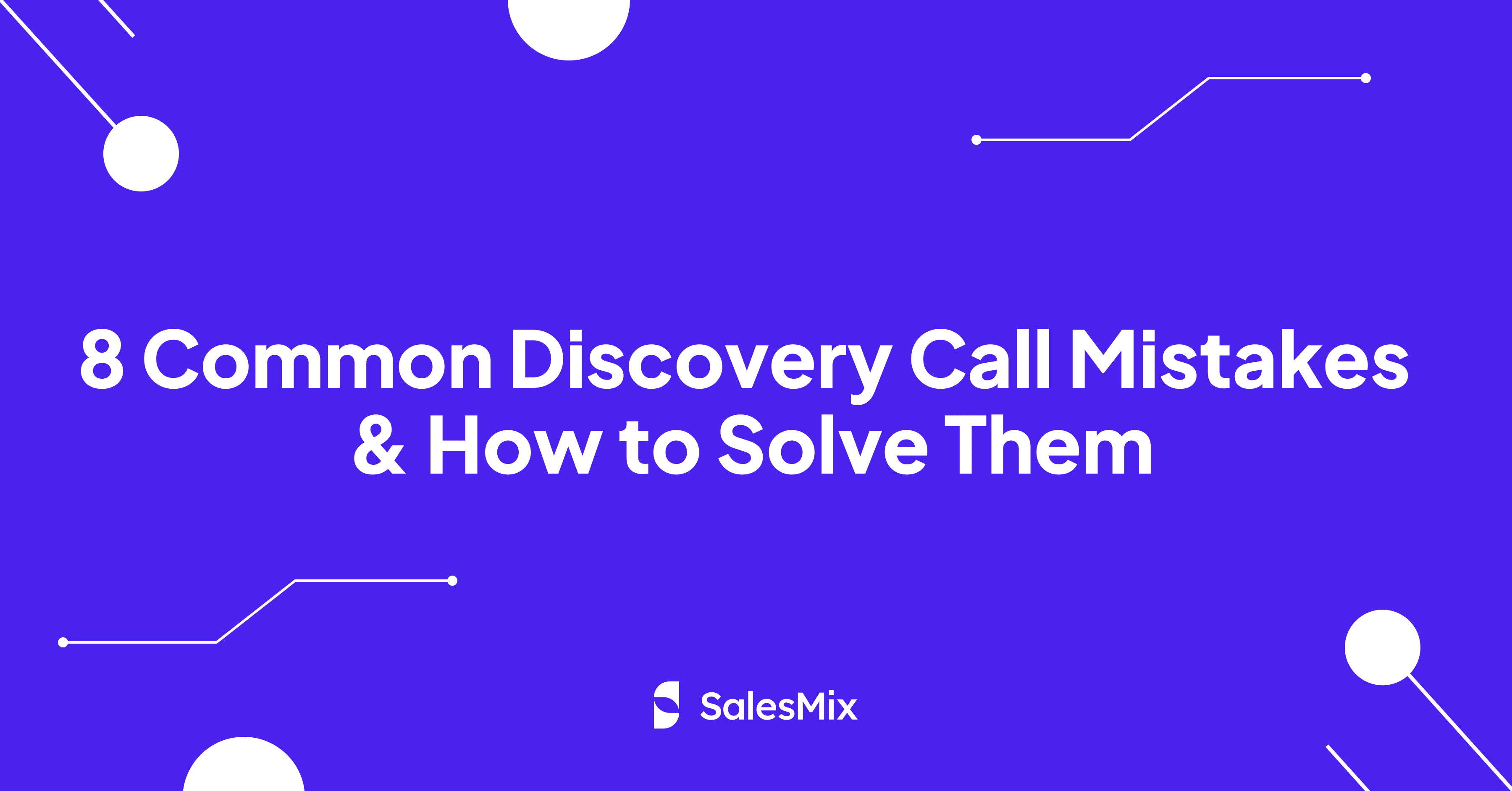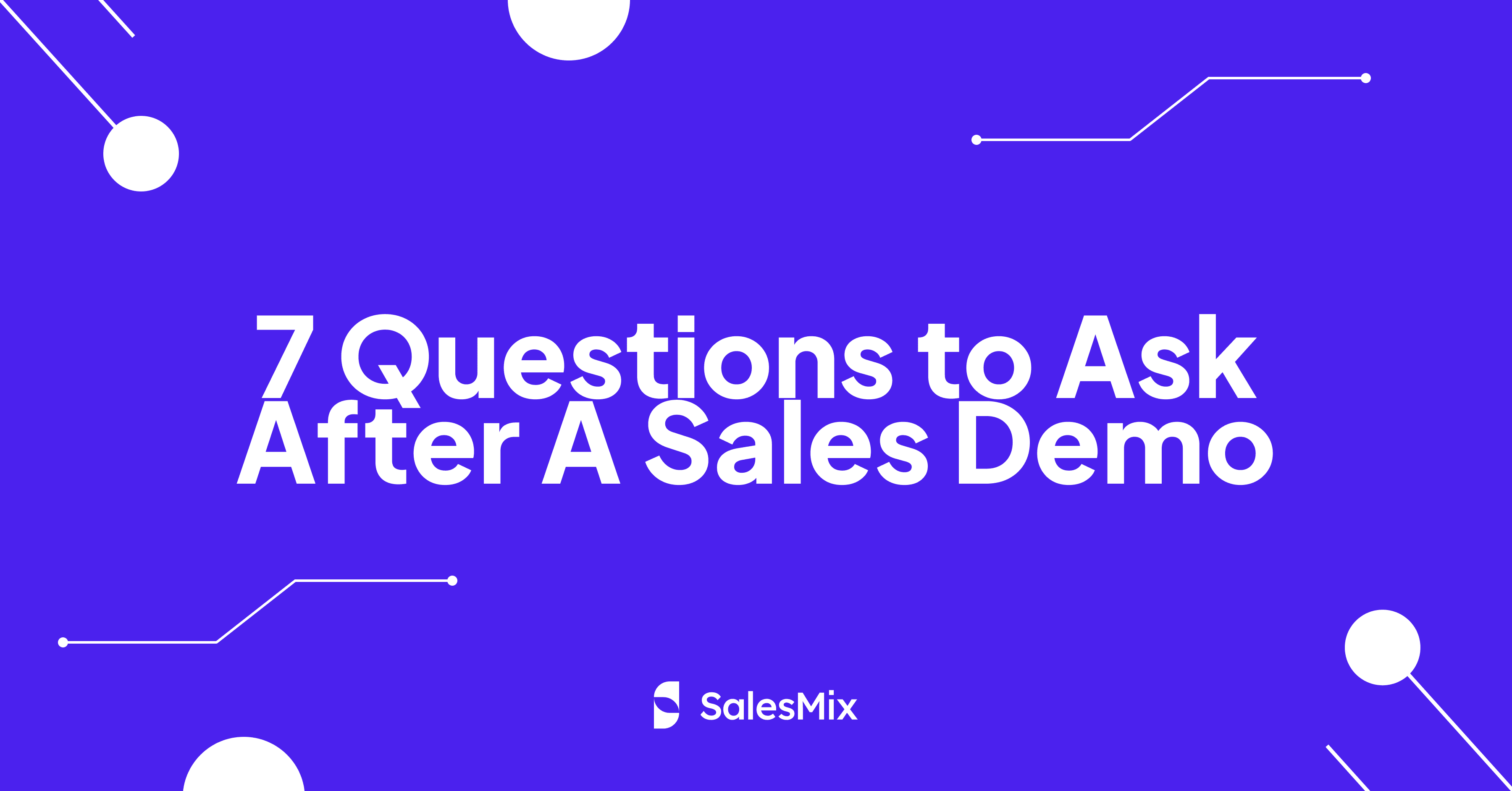Table Of Contents
Have you ever found yourself puzzled over the distinction between a cold email vs spam?
Cold email and spam are terms often used interchangeably, but they are fundamentally different in approach, legality, and reception by recipients. While both involve sending emails to potential contacts who have not interacted with you before, the similarities end there.
In this article, we will explore the nuances between cold emails and spam and actionable strategies to ensure your cold emails are effective.
What is a Cold Email?
A cold email is a targeted marketing tool used to initiate a conversation with potential customers who have no prior contact or interaction with your brand. Unlike other forms of email marketing, cold emailing is about reaching out to prospects with personalized, relevant content. The purpose of cold emailing is to ignite prospects’ interest or solve a specific problem they might have.
What is a Spam Email?
A spam email refers to unsolicited emails sent in bulk to a list of people without their prior consent. These emails often disrupt the recipient’s inbox and lead to potential trust issues between consumers and brands.
What are The Difference Between Cold Emails & Spam?
Understanding the difference between cold emails and spam is crucial for any marketer aiming to engage potential customers without crossing the line into unwanted communication.
Purpose of Contacting
The primary purpose of a cold email is to introduce the sender’s company or services to a potential client or partner who has not yet interacted with the brand but is deemed a good fit based on strategic targeting. This introduction is meant to be the beginning of a dialogue that you nurture over time, transforming a cold contact into a warm lead.
The goal of spam is often immediate and transactional— to elicit a quick action from the recipient, such as a purchase, click, or sign-up, without intending to foster a long-term relationship. It prioritizes quantity over quality and aim to reach as many people as possible with minimal effort.
Legality of The Emails
Cold emails, when done correctly, adhere to legal standards that respect the recipient’s privacy and provide them with a clear choice to engage further or opt-out. In countries like the United States, the CAN-SPAM Act sets the rules for commercial email conduct.
On the other hand, spam emails often flout these legal requirements. These bulk emails frequently employ misleading subject lines intended to deceive recipients into opening the message. Furthermore, spam rarely provides an easy opt-out mechanism, trapping recipients in an ongoing cycle of unwanted communication. Such practices violate anti-spam laws and expose the sender to legal penalties, including hefty fines.
Personalization
Cold emails are personalized communications sent to potential clients who have not yet interacted with your brand but have been identified as potentially interested parties based on targeted research. The essence of a cold email lies in its ability to speak directly to the recipient’s specific needs, interests, or business situations.
In the case of cold emails, you need to understand your target audience, including industry challenges, personal career achievements, or company milestones. It serves as a reference to create a connection and demonstrate genuine interest and insight.
In contrast, spam emails are generally generic, one-size-fits-all, and unsolicited emails that lack any form of personal touch. They are sent in bulk to a large number of recipients with no regard for their personal preferences or professional requirements. These emails typically push a product or service without establishing relevance to the recipient.
The Approach Style
Cold emails are strategic and thoughtful in their approach. They have a specific recipient in mind and aim to start a professional dialogue based on mutual interests and benefits. The style of a cold email is professional yet warm, focused yet engaging.
It begins by addressing the recipient by name and often references specific details that are relevant to them, such as recent company news or shared professional connections. This demonstrates that the sender has done their homework and sees a legitimate reason to connect beyond just selling a product or service.
On the other hand, spam emails typically adopt a one-size-fits-all approach. They are impersonal, often starting with generic greetings like “Dear user” or “Hello, friend,” and lack any personalized content that connects directly to the recipient’s personal or professional life. The language in spam is frequently urgent and pushy, with excessive use of exclamation points and high-pressure phrases like “Act now!” or “Limited time offer!”
Value Provided
Cold emails align the content with various insights to provide recipients with real value by offering solutions, opportunities, or information that is genuinely useful. It actually engages the recipient in a way that feels beneficial to them, presenting the sender as a helpful and knowledgeable partner.
Spam emails typically provide no real value to their recipients. They are often unsolicited messages that focus solely on the sender’s needs – to sell a product, generate leads, or simply get as many eyes as possible on an advertisement.
Moreover, spam emails often lead to negative experiences because they clutter the recipient’s inbox, potentially slow down their email system, and force them to spend time sorting and deleting unwanted messages. These actions provide a negative value, which can tarnish the reputation of the sender.
Honesty About Purpose & Source of The Recipient’s Address
A fundamental aspect that differentiates cold emails from spam is the transparency and honesty in the emails.
Cold emails go with a clear and upfront declaration of intent. When someone sends a cold email, they typically introduce themselves, their company, and the reason for their outreach at the beginning of the message. This approach is not just about being polite; it’s about setting the stage for a transparent relationship.
Spam emails often obscure or completely hide their true intentions. They may use misleading subject lines or deceptive content that suggests a familiarity or a relationship with the recipient that doesn’t exist, purely to trick the recipient into opening the email. They rarely provide information about how the sender obtained the recipient’s email address, which can lead to distrust and discomfort from the start.
Recipient Perception
When a recipient receives a cold email, the level of personalization, the relevance of the content, and the overall professional presentation can lead them to perceive the email as a legitimate business inquiry or opportunity. This type of email acknowledges the recipient’s potential value as a client or partner and shows respect for their time and attention, which can foster a positive response.
Spam emails often generate a negative perception immediately upon receipt. These emails are typically generic, unrequested, and irrelevant to the recipient’s personal or professional interests.
This lack of personal connection and the impersonal nature of the communication can make recipients feel undervalued and disrespected. As a result, spam emails often result in irritation and are quickly discarded or marked as spam, damaging the sender reputation to the email service provider and deliverability in the process.
How can You Create Cold Emails Without Being Spam?
Let’s see some of the best ways you can create cold emails that will not end up in being spam.
Utilize Proper Email Warmup
Email warmup involves gradually increasing the volume of emails sent from a new email account to build a positive sending reputation with Internet Service Providers (ISPs). When an ISP sees a sudden spike in email activity from a new account, it often flags this as suspicious, similar to behaviors exhibited by spammers.
A warmup process helps to avoid these red flags by showing consistent and predictable email behavior. It starts with sending a few emails per day and gradually increasing the number over time.
During this period, it’s crucial to engage with well-known and reputable contacts who are likely to open and respond to your emails. These positive interactions (like replies, moving emails from the spam folder into the inbox, or marking them as important) contribute positively to your sender reputation to ISPs.
Ensure Proper Email Authentication
Email authentication involves setting up several technical standards that confirm your emails are coming from a trusted source and that the content has not been altered in transit. The three main protocols used for this purpose are –
-
SPF (Sender Policy Framework),
-
DKIM (DomainKeys Identified Mail), and
-
DMARC (Domain-based Message Authentication, Reporting, and Conformance).

Check email leads with the in-built authentication tool in SalesMix.
Implementing these authentication standards can significantly increase your email deliverability. It reassures email service providers that your messages are legitimate and safe, reducing the likelihood of them being flagged as spam.
Proper email authentication can also protect your brand’s reputation by preventing phishing and spoofing attacks, where attackers might use a forged email address under your domain to send malicious emails.
Properly Maintain Your Email List
Properly maintaining your email list is not just about avoiding spam filters; it’s about fostering genuine engagement and building lasting relationships with your audience. Doing so will help you create a more focused and effective marketing effort that resonates well with your Ideal Customer Profile (ICP).
Regular cleaning of your email list is necessary to remove unengaged subscribers and invalid email addresses. It is crucial because sending emails to inactive or non-existent email addresses can significantly increase your bounce rates. High bounce rates can lead to your email domain being blacklisted.

Update your email list by editing or deleting contacts in SalesMix
To build a solid foundation for your list, you should acquire email addresses through transparent and ethical means. You must also ensure that potential contacts understand why they are receiving emails from you by using clear opt-in methods and providing a straightforward explanation of what type of content they can expect.
Use Persuading Subject Lines
Creating compelling and persuasive subject lines is an art that significantly boosts the effectiveness of cold email campaigns without veering into spam territory. The subject line is the first impression you make on the recipient, and it can dictate whether your email gets opened or ignored.
The key to crafting persuasive subject lines for cold emails lies in striking a balance between curiosity and clarity. Your subject line should clearly convey the value or benefit that awaits the recipient inside the email, yet it should be intriguing enough to prompt them to open the email.
It’s also important to personalize the subject line whenever possible. Including the recipient’s name or referencing something specific to their business can make the email feel more tailored and less like a mass-sent spam message.

Write compelling and personalized subject lines in SalesMix.
You should avoid using overly salesy language or deceptive subject lines, as this can trigger spam filters and lead to negative perceptions about your brand. Phrases like “Buy now” or “Free offer” can make your email look like spam and deter recipients from taking your message seriously.
Personalize Your Email Content
Personalizing your email content is essential in distinguishing your cold emails from spam and ensuring they resonate with recipients. It goes beyond simply inserting the recipient’s name in the email by tailoring the entire message to meet the specific needs, interests, or challenges of the recipient.
You need to understand the recipients’ industry, role, recent company achievements, and current challenges. This knowledge allows you to craft an email that speaks directly to their needs or offers solutions that are genuinely beneficial to them.
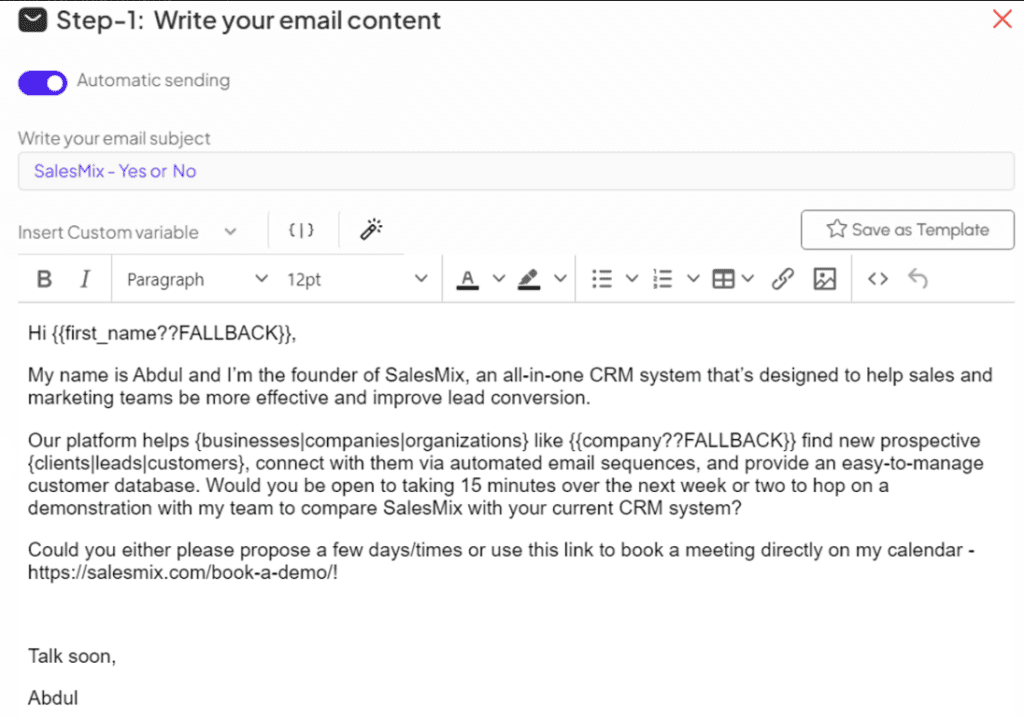
Easily personalize your email with SalesMix.
It’s also crucial to reference any previous interactions or touchpoints. For instance, mention a recent conference both of you attended or a mutual connection. If there’s no such thing, you can mention any interaction you have had with the recipients’ products or services to start a conversation, showing you’re genuinely interested.
Avoid Triggering Spam Filters
One of the primary ways to avoid spam filters is to ensure that your emails do not contain any of the common trigger words often associated with spam. These include overly promotional phrases like “buy now,” “free,” “guarantee,” or “no obligation.” Instead, you should choose language that is professional and aligned with normal business communication.
Another important factor is maintaining a clean and professional format. Emails that are overly busy or cluttered with different fonts, colors, and images can often be flagged by spam filters. You should keep your email layout simple and clean, with a well-structured body and a clear, concise message.
Include An Unsubscribe Link
Including an unsubscribe link in your cold emails helps you comply with laws like the CAN-SPAM Act in the United States and GDPR in Europe. It’s a practice that respects the recipient’s choice and helps maintain the integrity of your cold email marketing campaigns to enhance the trust and credibility of your brand.
An unsubscribe link reassures recipients that they are in control of what they receive in their inbox. Aside from including a valid physical location, like your office address or post office box, an unsubscribe link is also crucial for building long-term business relationships based on trust and mutual respect.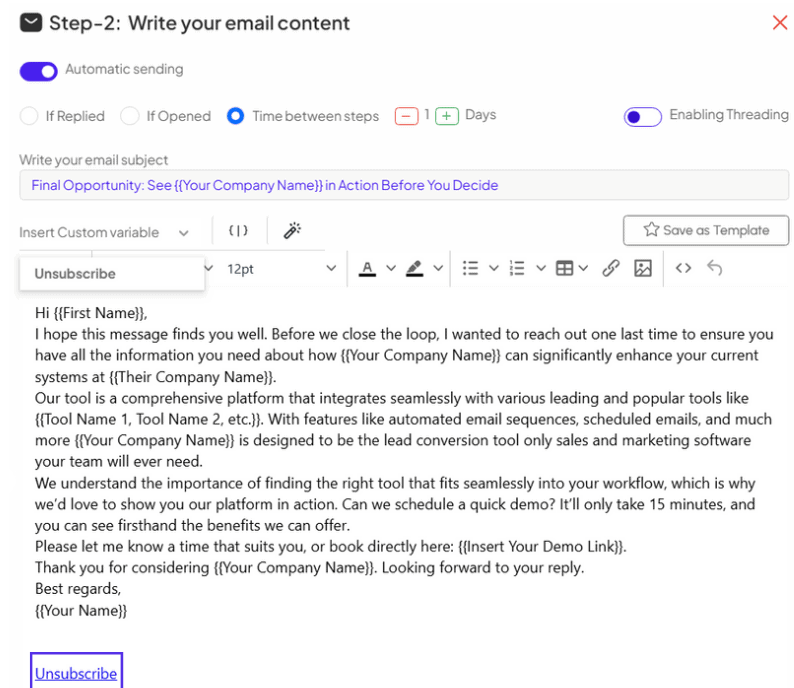
Add a cold email unsubscribe link with SalesMix.
When recipients know that they can easily stop receiving emails at any time with the opt-out requests, they’re more likely to view your communications as considerate and customer-focused rather than intrusive or spammy.
When recipients who are not interested in your offerings opt-out, it leaves a cleaner, more engaged email list. It means that your open and click-through rates are more reflective of an audience genuinely interested in your products or services, which allows for more accurate assessments and adjustments to your email strategies.
Monitor Your Cold Email Metrics
Monitoring your cold email metrics is an essential practice for ensuring that your email campaigns are effective and do not drift into the realm of spam. By keeping a close eye on how your emails perform, you can gain valuable insights that allow you to fine-tune your strategies and maintain your email list’s health.
Key metrics to monitor include open rates, reply rates, bounce rates, and unsubscribe rates. Each of these metrics offers a different perspective on how well your emails are being received and where improvements might be needed.
Regularly reviewing these metrics allows you to make data-driven decisions that can significantly improve the effectiveness of your cold email campaign. Adjusting your emails based on these insights ensures that your content remains fresh, relevant, and engaging and reduces the risk of your emails being spam.
How To Send Effective Cold Emails with SalesMix?
Sending effective cold emails that resonate with your audience without falling into the spam folder can be a challenging endeavor. However, SalesMix lets you significantly enhance your cold email campaigns, ensuring they reach the recipient’s inbox and engage them effectively.
One of the standout features of SalesMix is its robust email warmup capability. It ensures that your cold emails have a higher chance of landing in the recipient’s primary inbox rather than getting sidelined into the spam folder.
With a simple one-click setup, you can start warming up your email account on any email provider. The process involves a network of automated emails that engage with each other, methodically moving your emails out of the spam folder and improving your sender reputation over time.

Automated Email Warmup in SalesMix
Personalization is key to making your cold emails stand out and feel relevant to the recipients. SalesMix facilitates advanced personalization by using data from your CSV files.
You can easily insert personalized elements such as the recipient’s first name or tailor your message to resonate more closely with their specific business context. For example, using placeholders like {{first_name??FALLBACK}} ensures that the email addresses the recipient directly, while Spintax allows you to vary the words used (e.g., {businesses|organizations|companies} to keep the content fresh and engaging. This level of personalization helps in building a connection with your recipient, increasing the likelihood of a response.

Use Spintax in SalesMix for more variations in your cold emails.
SalesMix also offers a test email feature that allows you to send emails to designated recipients to check if your messages are landing in the inbox or the spam folder.
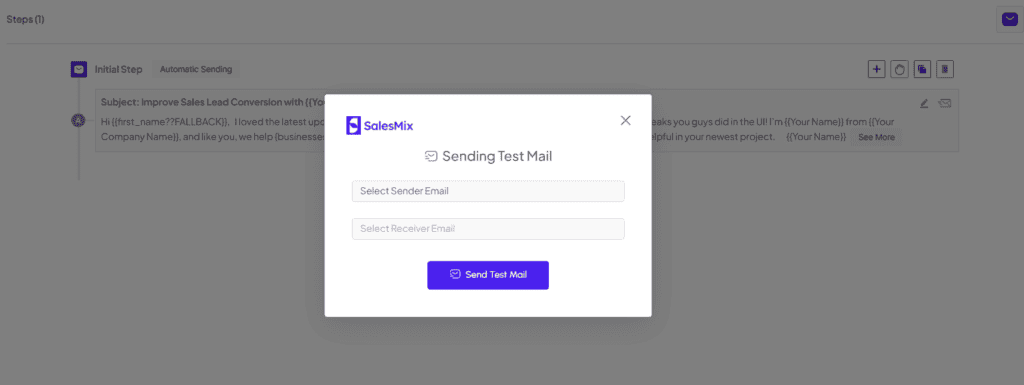
Test your email deliverability with SalesMix.
Conclusion
Knowing the subtle distinctions between cold emailing and spamming can transform your outreach from a potential nuisance into a powerhouse of effective communication and lead generation.
As you move forward, it’s crucial to harness the strategies discussed to comply with legal standards and significantly elevate the quality of interactions with your potential clients. The real magic will happen through the continuous refinement of your approach based on feedback and performance metrics.

